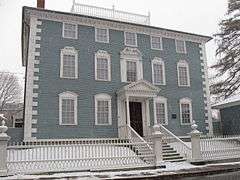Moffatt-Ladd House
|
Moffatt-Ladd House | |
|
The Moffatt-Ladd House in December 2009 | |
  | |
| Location | 154 Market Street, Portsmouth, New Hampshire |
|---|---|
| Coordinates | 43°4′43.91″N 70°45′32.17″W / 43.0788639°N 70.7589361°WCoordinates: 43°4′43.91″N 70°45′32.17″W / 43.0788639°N 70.7589361°W |
| Built | 1763 |
| Architect | Unknown |
| Architectural style | Georgian |
| NRHP Reference # | 68000010 |
| Significant dates | |
| Added to NRHP | November 24, 1968[1] |
| Designated NHL | November 24, 1968[2] |
The Moffatt-Ladd House, also known as the William Whipple House, is a historic house museum and National Historic Landmark at 154 Market Street in Portsmouth, New Hampshire, United States. The 1763 Georgian house was the home of William Whipple (1730–85), a signer of the Declaration of Independence and Revolutionary War general. The house is now owned by the National Society of Colonial Dames in New Hampshire, and is open to the public.
Among the contents are Whipple's sword and other personal items, along with a portrait of him. Outside is a horse chestnut tree that Whipple planted in 1776 with seeds that he brought back from Philadelphia.[3] The house was declared a National Historic Landmark in 1968.[2][4]
Description
The house is an imposing three-story wood frame structure, set on a rise overlooking the old part of Portsmouth Harbor. It is roughly square, measuring about 42 feet (13 m) on each side, with a hip roof. The exterior is covered in wood clapboards, with quoins at the corners. There are three chimneys, located at the sides of the house. The main facade is five bays wide; its windows on the first two levels are topped by segmented arch pediments, while the third level windows, which are smaller, butt against the roof cornice in Federal style. The roof topped by a flat widow's walk surrounded by a low balustrade with urn finials. The urn finials also appear on the fence that sets the house off from the street. The property includes a small office building dating to 1810.[4]
History
The house was built in 1763 by John Moffatt, one of the wealthiest men in colonial New Hampshire, and given to his son Samuel as a wedding present the following year. The elder Moffatt repurchased the house from his son in 1768, and lived there with his daughter Catherine and her husband, Wiliam Whipple, until his death in 1784.[4] The property was entailed by Moffatt to Samuel's descendants, who acquired control of the property after legal disputes in 1818. The house passed the following year to Maria Tufton Haven Ladd, one of Samuel's granddaughters.[5]
Maria Ladd's son Alexander Hamilton Ladd occupied the house until his death in 1900, and was responsible for establishing the property's fine gardens. His children donated the house to the National Society of Colonial Dames in New Hampshire in 1911.[6]
The house was declared a National Historic Landmark in 1968, and listed on the National Register of Historic Places.[1]
Photo gallery
 1915 postcard
1915 postcard 1905 photo of the Moffatt-Ladd House
1905 photo of the Moffatt-Ladd House
See also
- List of National Historic Landmarks in New Hampshire
- National Register of Historic Places listings in Rockingham County, New Hampshire
References
- 1 2 National Park Service (2007-01-23). "National Register Information System". National Register of Historic Places. National Park Service.
- 1 2 "Moffatt-Ladd House". National Historic Landmark summary listing. National Park Service. Retrieved 2007-10-21.
- ↑ Never too late: Declaration signers being honored, Associated Press article, July 3, 2011, accessed July 3, 2011
- 1 2 3 Charles W. Snell (February 25, 1971). "National Register of Historic Places Inventory-Nomination: Moffatt-Ladd House / William Whipple House" (pdf). National Park Service. and Accompanying 5 images, exterior and interior, from 1967, 1968 and undated. (3.14 MB)
- ↑ "The Whipples". Moffatt-Ladd House. Retrieved 2014-07-10.
- ↑ "The Ladds". Moffatt-Ladd House. Retrieved 2014-07-10.
External links
| Wikimedia Commons has media related to Moffatt-Ladd House. |

